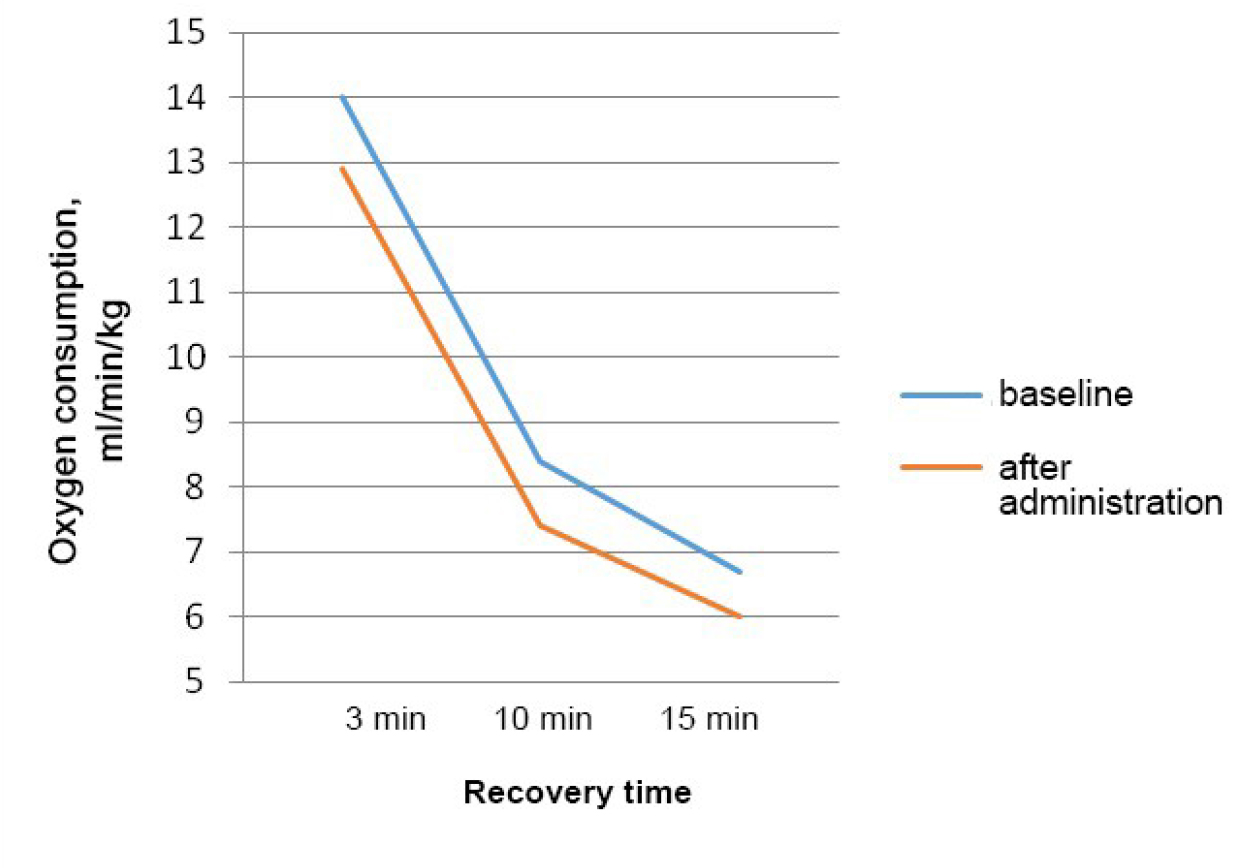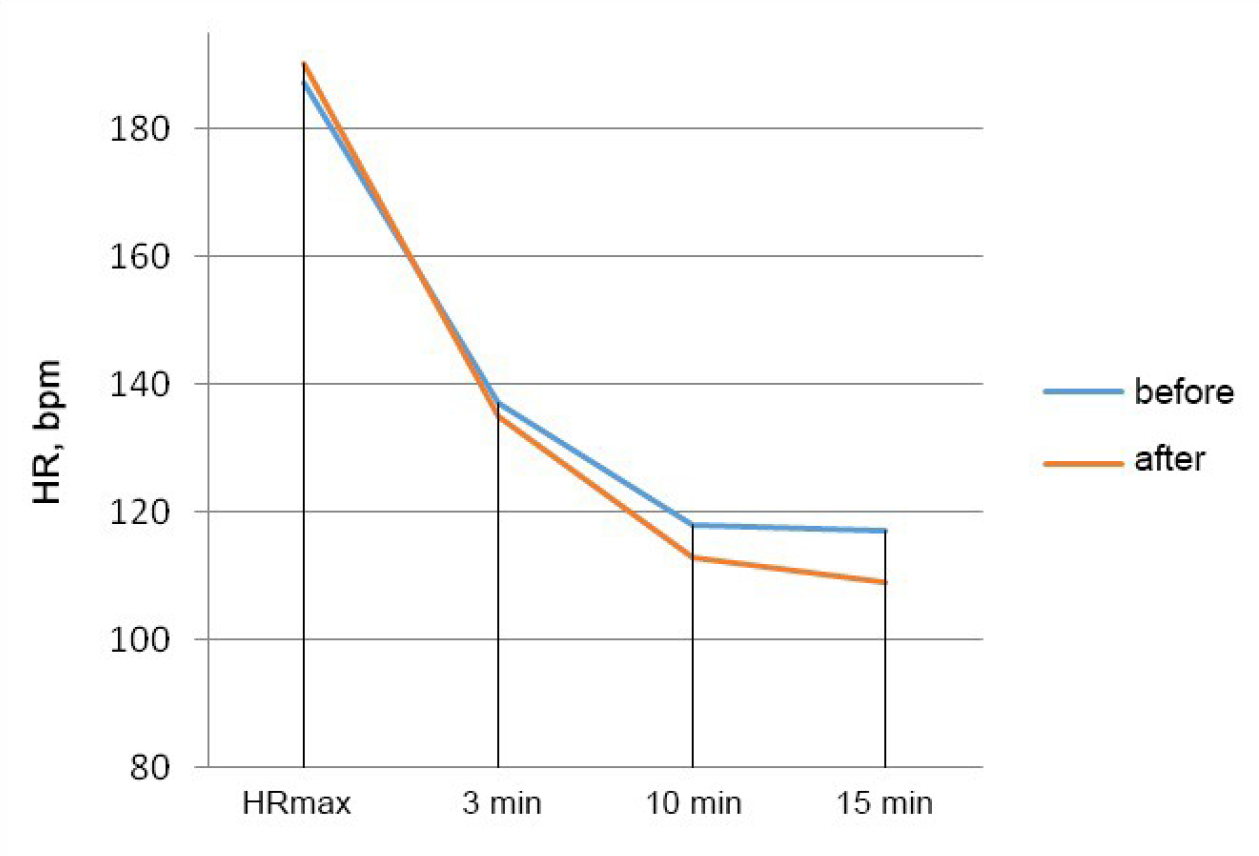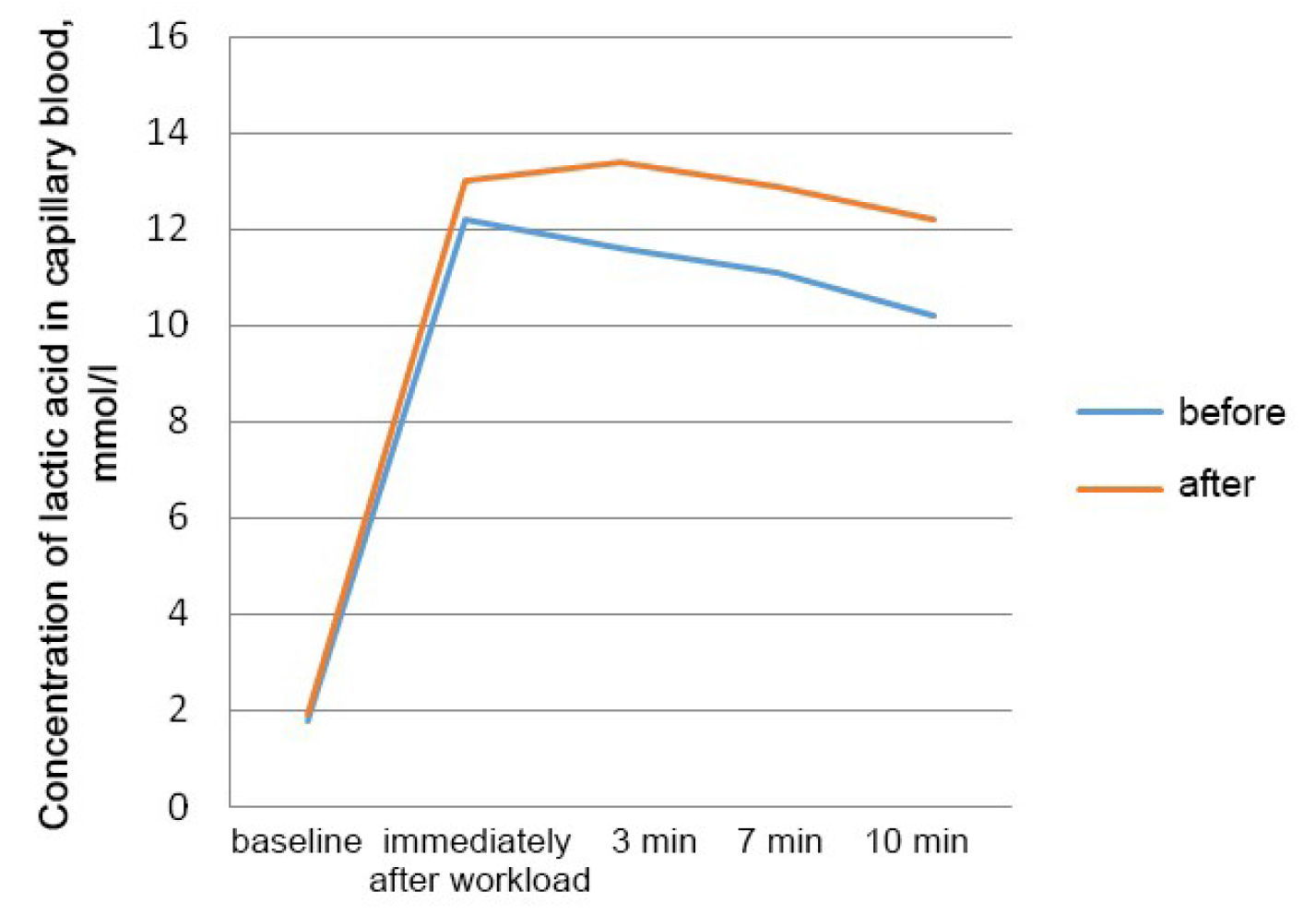Effects of exogenous ammonium succinate in minor doses on athletes' cardiovascular and respiratory systems during recovery after aerobic exercise
Фотографии:
ˑ:
Professor, Dr.Biol. R.V. Tambovtseva1
Associate professor, PhD J.L. Voytenko1
Associate professor, PhD A.I. Laptev1
O.S. Zhumaev 1
1Russian State University of Physical Culture, Sport, Youth and Tourism (SCOLIPC), Moscow
Introduction. Today it is a matter of common knowledge that exogenous succinate (administered per os), being quickly absorbed into the blood and tissues, gets actively involved in the energy metabolism. The succinate absorption rate increases significantly under physical load [1, 2, 3, 4]. As found by M.N. Kondrashova and her school [5], succinate matches all metabolic criteria: at the level of energy metabolism - it is the most effective substrate; succinate has several significant advantages over other metabolites under hypoxic conditions and is easily oxidized when administered per os. This poses the question: how effectively does this substrate, administered per os as a single minor dose, affect the physiological parameters of the whole body during the recovery period.
Objective of the study was to explore the effects of ammonium succinate on the cardiovascular and respiratory systems in elite athletes during the recovery period after an aerobic exercise.
Methods and organization of the study. The experiment was conducted at the Muscular Activity Bioenergetics Laboratory of the Sport Biochemistry and Bioenergetics Department named after N.I. Volkov. The study was performed at no risk for human health in compliance with the internationally accepted provisions on humanity and ethical standards (as provided by the 2000 Helsinki Declaration and EU Directive 86/609). The study involved 22 elite athletes, who gave their informed consents on the experiment. 30 minutes prior to the submaximal cycle ergometer step test, the testees were proposed to administer per os a single standard dose of ammonium succinate of 30 mg per kilo of body mass (Note that the substance was qualified a food additive and permitted for use by the State Committee for Sanitary and Epidemiological Supervision of the RF Decision (SanPiN 2.3.2. 1078-01). Besides, a group of athletes administering a placebo substance (microcrystalline cellulose) was examined separately. The following parameters were measured: power rates, heart rate, respiratory rates such as oxygen consumption, breathing rate, pulmonary ventilation, respiratory coefficient, respiratory and cardiovascular systems recovery rates, oxygen utilization rate during the 3rd, 10th, 15th minutes of the recovery period. The gas evaluation analysis was conducted in a sitting position using a cycle ergometer (without cycling). The lactic acid concentration in the blood was measured by means of the enzymatic method using the photometric assembly "Doctor Lange" and the standard assay kit produced by "Beringer" (Germany). The blood samples were taken in the initial state, immediately after exercising and during the 3rd, 10th, and 15th minutes of the recovery period.
Results and discussion. Table 1 presents the dynamics of indices of the cardiovascular and respiratory systems during the 3rd, 10th and 15th minutes of the recovery period.
Table 1. Cardiovascular and respiratory systems recovery rates after submaximal cycle ergometer step test (n = 22).
|
Recovery |
Parameter |
Baseline |
After succinate administration |
Changes |
% |
|
3 min |
HR, bpm |
137 + 6 |
135 + 5 |
2 |
- 1.5 |
|
OC, l/min |
1.04 + 0.11 |
0.97 + 0.06 |
0.07 |
- 6.73 |
|
|
Rel. OC, ml/min/kg |
14 + 1.9 |
12.9 + 0.9 |
1.1 |
-7.9 |
|
|
BR, 1/min |
29 + 2 |
29 + 1 |
0 |
0 |
|
|
V’E (BTPS) |
51 + 4 |
51 + 2 |
0 |
0 |
|
|
∆О2 |
2.86 + 0.13 |
2.7 + 0.14 |
0.16 |
-5.59 |
|
|
RER, max |
1.53 + 0.05 |
1.61 + 0.04 |
0.08 |
5.23 |
|
|
10 min |
HR, bpm |
118 + 4 |
113 + 3 |
5 |
-4.2 |
|
OC, l/min |
0.62 + 0.06 |
0.57 + 0.03 |
0.05 |
-8.06 |
|
|
Rel. OC, ml/min/kg |
8.4 + 0.8 |
7.4 + 0.2 |
1 |
-11.9* |
|
|
BR, 1/min |
23 + 1 |
23 + 1 |
0 |
0 |
|
|
V’E (BTPS) |
25 + 3 |
25 + 2 |
0 |
0 |
|
|
∆О2 |
3.58 + 0.15 |
3.32 + 0.13 |
0.26 |
-7.26* |
|
|
RER, max |
0.99 + 0.02 |
1.06 + 0.04 |
0.07 |
7.07* |
|
|
15 min |
HR, bpm |
117 + 4 |
109 + 4 |
8 |
-6.8* |
|
OC, l/min |
0.51 + 0.03 |
0.48 + 0.02 |
0.03 |
-5.88 |
|
|
Rel. OC, ml/min/kg |
6.7 + 0.3 |
6.0 + 0.3 |
0.7 |
-10.4* |
|
|
BR, 1/min |
20 + 2 |
20 + 1 |
0 |
0 |
|
|
V’E (BTPS) |
20 + 2 |
19 + 1 |
1 |
-5 |
|
|
∆О2 |
3.69 + 0.17 |
3.66 + 0.12 |
0.03 |
-0.81 |
|
|
RER, max |
0.88 + 0.02 |
0.9 + 0.02 |
-0.02 |
2.27 |
Note: * - significance of differences before and after the experiment (at р<0.05)
As shown in Table 1, the recovery rates for all the parameters under study is higher or remains at the same level compared to the baseline values, although the workload is high, and during the testing, the athletes’ performance indices are higher compared to the baseline values. It is shown that the external respiration parameters during the recovery period do not change under the influence of ammonium succinate, but remain the same compared to the baseline values. However, oxygen consumption is restored more quickly after the preparation administration, rather than without the administration of ammonium succinate. During the 10th and 15th minutes, the indices of the relative oxygen consumption (OC) (ml/min/kg) differ significantly from those registered before the experiment – these are the changes by 11.9% and 10.4%, respectively (at p<0.05) (Fig. 1) .

Figure 1. Dynamics of recovery of oxygen consumption (ml/min/kg) indices after submaximal load step test.
As shown in Fig. 1, the oxygen consumption recovery rate after the preparation administration is higher, although the maximum oxygen consumption rate after the testing equaled 43 ml/min/kg. Figure 2 illustrates the dynamics of changes in the heart rate during the recovery period without administration and after the administration of ammonium succinate. It is shown that after its administration heart rate in the testees is restored more quickly than without it.

Figure 2. Dynamics of heart rate recovery after submaximal load step test
The dynamics of the respiratory coefficient is of some interest as during the 10th minute of the recovery period it increases by 7% (p<0.05) compared to the baseline level. It can be assumed that the ammonium succinate preparation administration may result in the increase of the buffer system capacity.
Table 2 presents the changes in the lactic acid concentration in the blood before exercise and during the recovery period after the submaximal step test immediately after work and during the 3rd, 7th and 10th minutes.
Table 2. Indices of lactic acid concentration in the capillary blood after submaximal load step test (n = 22)
|
Lactic acid sampling time |
Baseline, mmol/l |
After succinate administration, mmol/l |
Changes |
% |
|
Baseline |
1.8 + 0 |
1.9 + 0.1 |
-0.1 |
5.6 |
|
Immediately after exercise |
12.2 + 0.6 |
13 + 0.5 |
-0.8 |
6.6 |
|
3 min |
11.6 + 0.8 |
13.4 + 0.6 |
-1.8 |
15.5* |
|
7 min |
11.1 + 0.8 |
12.9 + 0.8 |
-1.8 |
16.2* |
|
10 min |
10.2 + 0.7 |
12.2 + 0.6 |
-2 |
19.6* |
Note: * - significance of differences before and after the experiment (р<0.05).
The results of the dynamics of the lactic acid concentration in the capillary blood, registered at rest and immediately after the load in the initial state and after the ammonium succinate preparation administration do not differ significantly. However, as early as during the 3rd minute of the recovery period the lactic acid concentration ratios differ from each other by 15.5%; moreover, this difference only increases during the subsequent minutes of recovery, while the absolute lactate values decrease, as illustrated in Figure 3.

Figure 3. Dynamics of lactic acid concentration during recovery period after submaximal load step test
Due to the fact that under the influence of the ammonium succinate preparation the total work was performed in a large amount and with more power, the lactate concentration increased. It can be assumed that succinic acid stops the metabolic acidosis, owing to which the excessive lactic acid is utilized, which leads to the improvement and fast recovery of the energy status of the muscle tissue.
Therefore, it can be noted that the data obtained do not contradict but, on the contrary, confirm the results received earlier by M.N. Kondrashova and her school [5]. At the body level, exogenous succinate affects the energy exchange reactions. Ammonium succinate is a rather effective ergogenic metabolic preparation capable of improving physical performance and helping in the post-exercise recovery of the athletes' body.
Conclusions.
- After the administration of a single minor dose of exogenous ammonium succinate, the cardiovascular and respiratory systems recovery for all the parameters under study turns out to be faster, or remains at the same level compared to the baseline values, although the workload was high.
- The parameters of external respiration during the recovery period do not change under the influence of ammonium succinate, but remain the same compared to the baseline. However, oxygen consumption is restored faster after the preparation administration rather than without the administration of ammonium succinate.
- As early as during the 3rd minute of the recovery period the lactic acid concentration ratios differ from each other by 15.5%; moreover, this difference only increases during the subsequent minutes of recovery, while the absolute values of lactate decrease.
References
- Mayevskiy E.I., Grishina E.V., Rozenfeld A.S., Zyakun A.M., Kondrashova M.N., Vereshchagina V.M. Anaerobnoe obrazovanie suktsinata i oblegchenie ego okisleniya – vozmozhnye mekhanizmy adaptatsii kletki k kislorodnomu golodaniyu [Anaerobic production of succinate and its oxidation facilitation - possible mechanisms of cell adaptation to hypoxia]. Biofizika (Biophysics), 2000, vol. 45, no. 3, pp. 509 – 513.
- Mayevskiy E.I., Rozenfeld A.S., Grishina E.V., Kondrashova M.N. Korrektsiya metabolicheskogo atsidoza putem podderzhaniya funktsiy mitokhondriy [Correction of metabolic acidosis by maintaining mitochondrial function]. Pushchino, 2001, 155 p.
- Peskov A.B., Mayevskiy E.I., Uchitel' M.L., Kondrashova M.N. Platsebo-kontroliruemoe issledovanie simpatikotonicheskikh effektov biologicheski aktivnykh dobavok na osnove soley yantarnoy kisloty [Placebo-controlled study of sympathicotonic effects of succinic-acid-salt-based dietary supplements]. Biomeditsinskiy zhurnal, 2005, vol. 6, pp. 508 – 514.
- Tambovtseva R.V., Laptev A.I., Voytenko J.L., et al Vliyanie suktsinata ammoniya na aerobnye sposobnosti sportsmenov [Effects of ammonium succinate on aerobic performance of athletes ]. Teoriya i praktika fiz. kultury, 2016, no. 9, pp. 56-59.
- Kondrashova M.N. Terapevticheskoe deystvie yantarnoy kisloty [Succinic acid: therapeutic effect]. Pushchino, 1976, 234 p.
Corresponding author: ritta7@mail.ru


